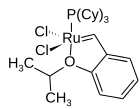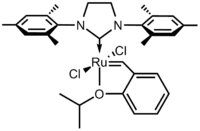Grubbs' catalyst
 | |
 | |
| Names | |
|---|---|
| IUPAC name
Benzylidene-bis(tricyclohexylphosphino)-dichlororuthenium | |
| Identifiers | |
| PubChem CID |
|
| Properties | |
| C43H72Cl2P2Ru | |
| Molar mass | 822.96 g·mol−1 |
| Appearance | Purple solid |
| Melting point | 153 °C (307 °F; 426 K) (decomposition) |
| Except where otherwise noted, data are given for materials in their standard state (at 25 °C [77 °F], 100 kPa). | |
| | |
| Infobox references | |
 | |
 | |
| Names | |
|---|---|
| IUPAC name
[1,3-bis-(2,4,6-trimethylphenyl)-2-imidazolidinylidene]dichloro(phenylmethylene)(tricyclohexylphosphino)ruthenium | |
| Identifiers | |
| Properties | |
| C46H65Cl2N2PRu | |
| Molar mass | 848,97 g·mol−1 |
| Appearance | Pinkish brown solid |
| Melting point | 143.5 to 148.5 °C (290.3 to 299.3 °F; 416.6 to 421.6 K) |
| Except where otherwise noted, data are given for materials in their standard state (at 25 °C [77 °F], 100 kPa). | |
| Infobox references | |
 | |
 | |
| Names | |
|---|---|
| IUPAC name
Dichloro(o-isopropoxyphenylmethylene)(tricyclohexylphosphine)ruthenium(II) | |
| Identifiers | |
| PubChem CID |
|
| Properties | |
| C28H45Cl2OPRu | |
| Molar mass | 600.61 g·mol−1 |
| Appearance | Brown solid |
| Melting point | 195 to 197 °C (383 to 387 °F; 468 to 470 K) |
| Except where otherwise noted, data are given for materials in their standard state (at 25 °C [77 °F], 100 kPa). | |
| Infobox references | |
 | |
 | |
| Names | |
|---|---|
| IUPAC name
[1,3-Bis-(2,4,6-trimethylphenyl)-2-imidazolidinylidene]dichloro(o-isopropoxyphenylmethylene)ruthenium | |
| Identifiers | |
| Properties | |
| C31H38Cl2N2ORu | |
| Molar mass | 626.62 g·mol−1 |
| Appearance | Green solid |
| Melting point | 216 to 220 °C (421 to 428 °F; 489 to 493 K) |
| Except where otherwise noted, data are given for materials in their standard state (at 25 °C [77 °F], 100 kPa). | |
| Infobox references | |
Grubbs' catalysts are a series of transition metal carbene complexes used as catalysts for olefin metathesis. They are named after Robert H. Grubbs, the chemist who first synthesized them. There are two generations of the catalyst, as shown on the right.[1][2] In contrast to other olefin metathesis catalysts, Grubbs' catalysts tolerate other functional groups in the alkene, are air-tolerant and are compatible with a wide range of solvents.[3][4] For these reasons, Grubbs' catalysts have become popular in synthetic organic chemistry.[5]
First-generation catalyst
The first well-defined ruthenium catalyst for olefin metathesis was discovered in 1992.[6] It was prepared from RuCl2(PPh3)4 and diphenylcyclopropene.
This initial ruthenium catalyst was followed in 1995 by what is now known as the first-generation Grubbs catalyst. It is easily synthesized from RuCl2(PPh3)3, phenyldiazomethane, and tricyclohexylphosphine in a one-pot synthesis.[7][8]
The first-generation Grubbs catalyst, while largely replaced by the second-generation catalyst in usage, was not only the first catalyst to be developed other than those developed by Richard R. Schrock (Schrock carbenes), but is also important as a precursor to all other Grubbs-type catalysts.
Second-generation catalyst
The second-generation catalyst has the same uses in organic synthesis as the first generation catalyst, but generally with higher activity. This catalyst is stable toward moisture and air, thus is easier to handle in the lab.
Shortly before the discovery of the second-generation Grubbs catalyst, a very similar catalyst based on an unsaturated N-heterocyclic carbene (1,3-bis(2,4,6-trimethylphenyl)imidazole) was reported independently by Nolan[9] and Grubbs[10] in March 1999, and by Fürstner[11] in June of the same year. Shortly thereafter, in August 1999, Grubbs reported the second-generation catalyst, based on a saturated N-heterocyclic carbene (1,3-bis(2,4,6-trimethylphenyl)dihydroimidazole):[12]
In both the saturated and unsaturated cases a phosphine ligand is replaced with an N-heterocyclic carbene (NHC), which is characteristic of all second-generation-type catalysts.[3]
Both the first- and second-generation catalysts are commercially available, along with many derivatives of the second-generation catalyst.
Hoveyda–Grubbs catalysts
In the Hoveyda–Grubbs catalysts, the benzylidene ligands have a chelating ortho-isopropoxy group attached to the benzene rings. The ortho-isopropoxybenzylidene moiety is sometimes referred to as a Hoveyda chelate. The chelating oxygen atom replaces a phosphine ligand, which in the case of the 2nd generation catalyst, gives a completely phosphine-free structure. The 1st generation Hoveyda–Grubbs catalyst was reported in 1999 by Amir H. Hoveyda's group,[13] and in the following year, the second-generation Hoveyda–Grubbs catalyst was described in nearly simultaneous publications by the Blechert[14] and Hoveyda[15] laboratories. Siegfried Blechert's name is not commonly included in the eponymous catalyst name. The Hoveyda–Grubbs catalysts, while more expensive and slower to initiate than the Grubbs catalyst from which they are derived, are popular because of their improved stability.[3] By changing the steric and electronic properties of the chelate, the initiation rate of the catalyst can be modulated,[16] such as in the Zhan Catalysts. Hoveyda–Grubbs catalysts are easily formed from the corresponding Grubbs catalyst by the addition of the chelating ligand and the use of a phosphine scavenger like copper(I) chloride:[15]
The second-generation Hoveyda–Grubbs catalysts can also be prepared from the 1st generation Hoveyda–Grubbs catalyst by the addition of the NHC:[14]
In one study a water-soluble Grubbs catalyst is prepared by attaching a polyethylene glycol chain to the imidazolidine group.[17] This catalyst is used in the ring-closing metathesis reaction in water of a diene carrying an ammonium salt group making it water-soluble as well.
Fast-initiating catalysts (third-generation Grubbs catalyst)
The initiation rate of the Grubbs catalyst can be altered by replacing the phosphine ligand with more labile pyridine ligands. By using 3-bromopyridine the initiation rate is increased more than a millionfold:[18]
The principle application of the fast-initiating catalysts is as initiators for ring opening metathesis polymerisation (ROMP). Because of their usefulness in ROMP these catalysts are sometimes referred to as the 3rd generation Grubbs' catalysts.[19] The high ratio of the rate of initiation to the rate of propagation makes these catalysts useful in living polymerization, yielding polymers with low polydispersity.[20]
Applications
Olefin metathesis is a reaction between two molecules containing double bonds. The groups bonded to the carbon atoms of the double bond are exchanged between molecules, to produce two new molecules containing double bonds with swapped groups. Whether a cis isomer or trans isomer is formed in this type of reaction is determined by the orientation the molecules assume when they coordinate to the catalyst, as well as the sterics of the substituents on the double bond of the newly forming molecule.
On October 5, 2005, Robert H. Grubbs, Richard R. Schrock and Yves Chauvin won the Nobel Prize in Chemistry in recognition of their contributions to the development of this widely used process.
References
- ↑ Grubbs, Robert H. (2003). Handbook of Metathesis (1st ed.). Weinheim: Wiley-VCH. ISBN 3-527-30616-1.
- ↑ Grubbs, R. H.; Trnka, T. M. (2004). "Ruthenium-Catalyzed Olefin Metathesis". In Murahashi, S. Ruthenium in Organic Synthesis. Weinheim: Wiley-VCH. doi:10.1002/3527603832.ch6.
- 1 2 3 Vougioukalakis, G. C.; Grubbs, R. H. (2010). "Ruthenium-Based Heterocyclic Carbene-Coordinated Olefin Metathesis Catalysts". Chem. Rev. 110 (3): 1746–1787. PMID 20000700. doi:10.1021/cr9002424.
- ↑ Trnka, T. M.; Grubbs, R. H. (2001). "The Development of L2X2Ru=CHR Olefin Metathesis Catalysts: An Organometallic Success Story". Acc. Chem. Res. 34 (1): 18–29. PMID 11170353. doi:10.1021/ar000114f.
- ↑ Cossy, Janine; Arseniyadis, Stellios; Meyer, Christophe (2010). Metathesis in Natural Product Synthesis: Strategies, Substrates and Catalysts (1st ed.). Weinheim: Wiley-VCH. ISBN 3-527-32440-2.
- ↑ Nguyen, S. T.; Johnson, L. K.; Grubbs, R. H.; Ziller, J. W. (1992). "Ring-opening metathesis polymerization (ROMP) of norbornene by a Group VIII carbene complex in protic media". J. Am. Chem. Soc. 114 (10): 3974–3975. doi:10.1021/ja00036a053.
- ↑ Schwab, P.; France, M. B.; Ziller, J. W.; Grubbs, R. H. "A Series of Well-Defined Metathesis Catalysts – Synthesis of [RuCl2(=CHR′)(PR3)2] and Its Reactions". Angew. Chem. Int. Ed. 34 (18): 2039–2041. doi:10.1002/anie.199520391.
- ↑ Schwab, P.; Grubbs, R. H.; Ziller, J. W. (1996). "Synthesis and Applications of RuCl2(=CHR′)(PR3)2: The Influence of the Alkylidene Moiety on Metathesis Activity". J. Am. Chem. Soc. 118 (1): 100–110. doi:10.1021/ja952676d.
- ↑ Huang, J.-K.; Stevens, E. D.; Nolan, S. P.; Petersen, J. L. (1999). "Olefin Metathesis-Active Ruthenium Complexes Bearing a Nucleophilic Carbene Ligand". J. Am. Chem. Soc. 121 (12): 2674–2678. doi:10.1021/ja9831352.
- ↑ Scholl, M.; Trnka, T. M.; Morgan, J. P.; Grubbs, R. H. (1999). "Increased Ring Closing Metathesis Activity of Ruthenium-Based Olefin Metathesis Catalysts Coordinated with Imidazolin-2-ylidene Ligands". Tetrahedron Lett. 40 (12): 2247–2250. doi:10.1016/S0040-4039(99)00217-8.
- ↑ Ackermann, L.; Fürstner, A.; Weskamp, T.; Kohl, F. J.; Herrmann, W. A. (1999). "Ruthenium Carbene Complexes with Imidazolin-2-ylidene Ligands Allow the Formation of Tetrasubstituted Cycloalkenes by RCM". Tetrahedron Lett. 40 (26). doi:10.1016/S0040-4039(99)00919-3.
- ↑ Scholl, M.; Ding, S.; Lee, C. W.; Grubbs, R. H. (1999). "Synthesis and Activity of a New Generation of Ruthenium-Based Olefin Metathesis Catalysts Coordinated with 1,3-Dimesityl-4,5-dihydroimidazol-2-ylidene Ligands". Org. Lett. 1 (6): 953–956. doi:10.1021/ol990909q.
- ↑ Kingsbury, Jason S.; Harrity, Joseph P. A.; Bonitatebus, Peter J.; Hoveyda, Amir H. (1999). "A Recyclable Ru-Based Metathesis Catalyst". J. Am. Chem. Soc. 121 (4): 791–799. doi:10.1021/ja983222u.
- 1 2 Gessler, S.; Randl, S.; Blechert, S. (2000). "Synthesis and metathesis reactions of phosphine-free dihydroimidazole carbene ruthenium complex". Tetrahedron Letters. 41 (51): 9973–9976. doi:10.1016/S0040-4039(00)01808-6.
- 1 2 Garber, S. B.; Kingsbury, J. S.; Gray, B. L.; Hoveyda, A. H. (2000). "Efficient and Recyclable Monomeric and Dendritic Ru-Based Metathesis Catalysts". J. Am. Chem. Soc. 122 (34): 8168–8179. doi:10.1021/ja001179g.
- ↑ Engle, Keary M.; Lu, Gang; Luo, Shao-Xiong; Henling, Lawrence M.; Takase, Michael K.; Liu, Peng; Houk, K. N.; Grubbs, Robert H. (2015). "Origins of Initiation Rate Differences in Ruthenium Olefin Metathesis Catalysts Containing Chelating Benzylidenes". Journal of the American Chemical Society. 137 (17): 5782–5792. doi:10.1021/jacs.5b01144.
- ↑ Hong, Soon Hyeok; Grubbs, Robert H. (2006). "Highly Active Water-Soluble Olefin Metathesis Catalyst". J. Am. Chem. Soc. 128 (11): 3508–3509. PMID 16536510. doi:10.1021/ja058451c.
- ↑ Love, J. A.; Morgan, J. P.; Trnka, T. M.; Grubbs, R. H. (2002). "A Practical and Highly Active Ruthenium-Based Catalyst that Effects the Cross Metathesis of Acrylonitrile". Angew. Chem. Int. Ed. Engl. 41 (21): 4035–4037. doi:10.1002/1521-3773(20021104)41:21<4035::AID-ANIE4035>3.0.CO;2-I.
- ↑ Leitgeb, Anita; Wappel, Julia; Slugovc, Christian (2010). "The ROMP toolbox upgraded". Polymer. 51 (14): 2927–2946. doi:10.1016/j.polymer.2010.05.002.
- ↑ Choi, T.-L.; Grubbs, R. H. (2003). "Controlled Living Ring-Opening-Metathesis Polymerization by a Fast-Initiating Ruthenium Catalyst". Angewandte Chemie International Edition. 42 (15): 1743–1746. doi:10.1002/anie.200250632.






